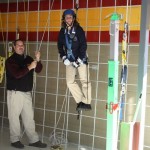Fall Protection Versus Fall Prevention: What’s The Difference?
 Fall prevention encompasses every kind of equipment and application that is specifically set up to keep a person from falling in the first place. The purpose of prevention equipment is to eliminate or control the possibility of a person moving into a dangerous area. Fall arrest protection, on the other hand, is the backup system for someone who must enter a dangerous area and could lose their balance while working at height. The purpose of protection equipment is to eliminate or minimize injury potential.
Fall prevention encompasses every kind of equipment and application that is specifically set up to keep a person from falling in the first place. The purpose of prevention equipment is to eliminate or control the possibility of a person moving into a dangerous area. Fall arrest protection, on the other hand, is the backup system for someone who must enter a dangerous area and could lose their balance while working at height. The purpose of protection equipment is to eliminate or minimize injury potential.
Coach Vince Lombardi said, “It’s not whether you fall down. It’s whether you get back up.” We agree with Coach Lombardi that, in life, getting back up is important. However, in the case of elevated work situations, whether you fall in the first place is equally, if not more, important. There are different mitigation techniques, depending on the hazard.
Eliminating The Hazard
Whenever possible (and practical), prevention should be used to eliminate hazards. This is often accomplished by changing the process or task so a person is no longer exposed to it. The following are example site-specific applications for hazard elimination, which is about stopping the person from being exposed to the risk in the first place.
- Industrial Application (Boiler Maintenance): Conducting inspection/maintenance of a boiler from the ground, as opposed to having to climb atop the boiler.
- Tanker Truck Unloading and Loading Applications: Purchasing only tank trucks that are loaded and unloaded from ground level, eliminating the need to climb to the top of the truck.
Restricting Access To Hazard
When eliminating hazards is impractical, the next best solution is to restrict access to it by putting up a barrier or otherwise restraining a person from reaching it. The following are example site-specific applications illustrating how access to hazards restricted, thus, minimizing or eliminating the risk, either by putting up a barrier to set them off by restraining a worker’s movement, or preventing a worker from reaching unprotected areas.
- Industrial Application: Conducting inspection/maintenance of a boiler from a guardrail secured platform on top of the boiler.
- Tanker Truck Unloading and Loading Application: Installing a portable ladder system with a cage that allows the worker to fill the tank while safety railing protects the platform edges.
- Roofing Application: Inhibiting someone from going over the edge by installing guardrails along the roof edge (restricts access). In the case of a horizontal lifeline system, a worker could tie off with a specific length lanyard, allowing them certain travel distance but not to reach the roof edge (restrains worker movement).
- Access Hatches Application: Corralling roof hatches with self-closing safety gates and a guardrail system, or a self-closing lid over the hatch.
- Roof Skylight Application: Corralling skylights with railings, or enclosing them in wire-mesh cages.
Fall Protection and Arresting A Potential Free Fall
When access and exposure to the hazard cannot be prevented or limited due to the nature of the task being done, a worker must have a backup system in place. The following are example solutions for site-specific applications:
- Industrial Application (Boiler Maintenance): Using single-point anchor points, the worker is able to be tied off while while working on top of the boiler.
- Tanker Truck Unloading And Loading Applications: Including an overhead cable lifeline for the worker to freely climb atop the tanker.
- Roofing Application: Designing a lifeline system to protect a worker from falling through the roof or over the edge, taking into account fall clearances and other hazards.
- Access Hatches Application: Tying a worker off from above to a lifeline system, so if they were to accidentally step into a hole, the system would arrest their movement prior to hitting the next lower level.
- Vertical Ladder Application: Installing a vertical cable lifeline or single-point anchor to protect a worker while climbing the ladder.
- Roof Skylights: Netting the underside of skylights with personal-rated netting to catch a worker who broke through the skylight.
Fall protection is about having a backup solution in place to minimize injuries associated with industrial accidents. There are a variety of applications available to optimize safety for your workers. Finding the right solution for your manufacturing facility, distribution warehouse or construction site is best determined by experts who will conduct an on-site assessment of your workplace. Through this survey, you are able to determine what combination of prevention and protection you need to enable your crew to safely work from heights.
Ready to learn more about finding the right solution for your job site or facility? Click on the button below to contact us by phone, or you may send us a written inquiry, along with a short description of your needs.

